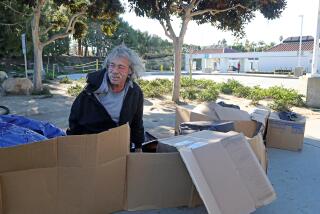Santa Monica Backs Off on Restaurant Smoking Curb
The Santa Monica City Council will consider a watered-down no-smoking ordinance for the city’s restaurants, after shooting down a stronger version of the law that drew a barrage of complaints from restaurateurs.
In a 6-1 vote at its Tuesday night meeting, the council decided to return a proposed no-smoking ordinance to city attorneys for rewriting. The revisions called for will reduce the number of seats that have to be set aside for nonsmokers and will exempt from the law restaurants with fewer than 50 seats.
“This is a wimp ordinance,” said Councilman Alan Katz, who had failed in several attempts to restore some of the original law’s teeth, after the vote. “(The revisions) undercut the purpose: preserving the health of restaurant patrons.”
Katz ultimately voted with the majority, however, because he said, a revised law is better than nothing.
Originally a 70% Curb
The original measure would have required all Santa Monica restaurants to set aside 70% of their seats for nonsmokers, with no exemptions allowed for smaller establishments. Those features made the proposed law tougher than similar restaurant-smoking curbs recently passed in Los Angeles and Beverly Hills.
A joint motion by council members Chris Reed and Dennis Zane instructed city lawyers to reduce the number of nonsmokers’ seats to 50% of the restaurants’ capacity. In addition to exempting smaller restaurants, the new version of the law would also exempt bars and hotel banquet rooms. Outdoor seating would not be included in calculating a restaurant’s capacity.
The proposed revisions pleased seven restaurant owners and their supporters, who came to the meeting to protest the original proposal, saying that a too-tough ordinance would cost them business.
However, half a dozen cancer and heart disease experts and other advocates of nonsmokers’ rights were disappointed--and surprised.
Dr. William McCarthy, chairman of the Public Issues Committee of the American Cancer Society, said that he and other health organization representatives had let down their guard, thinking that a reputedly liberal city like Santa Monica would readily enact the measure.
“We had thought this (passing the original ordinance) was going to be a breeze. Santa Monica is a progressive city,” he said. “(But) we were outflanked by the restaurant association. They set the tone for the meeting.”
‘Rolling’ Sections
Now, McCarthy said, he and other nonsmoking advocates will step up a letter-writing campaign and recruit volunteers to lobby against the weaker law. He said he hopes that the council can be persuaded to again reduce the size of restaurant smoking sections.
The rewritten ordinance should come before the council within two months, Deputy City Atty. Laurie Lieberman said.
In its Tuesday night discussion, the council also instructed city lawyers to study and possibly include a provision that would allow restaurant managers to “roll” their no-smoking sections. This means that managers would be given discretion to allocate seats to smokers or nonsmokers as those customers appear; there would be no fixed designations.
“This is almost no ordinance,” said Donald Nelson, former regional director of the American Lung Assn. and a current city planning commissioner, who appeared at the meeting to voice support for the original proposal.
“A proposal for ‘rolling’ is a proposal for abuse. It leaves no clear-cut plan,” he asserted.
The city staff had also argued that a “rolling” no-smoking section would create uncertainty in the minds of nonsmokers about its location and that it would severely weaken the law by making it hard to enforce, since the section’s boundaries would be moving.
Could Have Been a Model
Councilman David Finkel, who voted against the revisions, lashed out at his fellow council members for descending into the “banal and mundane” by failing to adopt the tougher curbs and set an example for other municipalities. He called for the outlawing of smoking in all public places.
Restaurateurs felt that they had scored a victory.
“That’s fine. This gives us a chance to work with the city and come up with something that will work,” Gerald Breitbart, a spokesman for the California Restaurant Assn., said as the council prepared to vote.
Restaurant owners had argued that the 70% allocation for nonsmokers, which the city said was based on figures for smokers and nonsmokers in the general population, was too high. They complained that they would be left with empty no-smoking tables, while unseated smokers waited.
They also argued that smoking-section rules should be flexible because the ratio between smokers and nonsmokers fluctuates, depending on whether it is a lunch or dinner crowd, the type of restaurant and whether it caters to a heavier-drinking clientele.
‘I’m at Your Mercy’
Small restaurants would have been especially hurt, the owners argued.
“This would put me out of business,” said Jay Fiondella, who has run Santa Monica’s 46-seat, 10-table Chez Jay for 29 years, of the original ordinance.
“I’m at your mercy,” he told the council.
Restaurant owners said that they do not object to providing no-smoking sections but that they should be allowed to do it voluntarily, without setting fixed ratios that “tie the hands” of managers.
In a staff report, the city attorney’s office said it conducted an informal telephone survey and found that about 26% of Santa Monica’s restaurants have voluntarily created no-smoking areas, a percentage that the staff lawyers considered inadequate.
In 1984, Santa Monica passed a comprehensive law banning smoking in numerous public places such as grocery stores, movie houses, elevators and public restrooms. Restaurants lobbied successfully at the time to be excluded by pledging to voluntarily set up no-smoking sections, install better ventilation or take other measures.
“We are continually getting asked by citizens (for a nonsmoking ordinance), which tells me the voluntary plan is not working,” Reed said before Tuesday night’s meeting.
More to Read
Sign up for Essential California
The most important California stories and recommendations in your inbox every morning.
You may occasionally receive promotional content from the Los Angeles Times.











